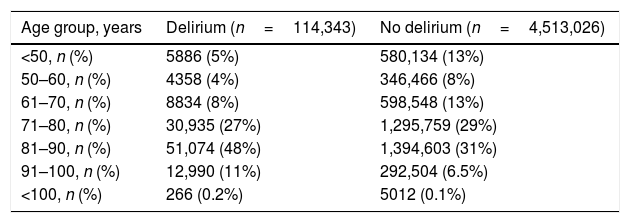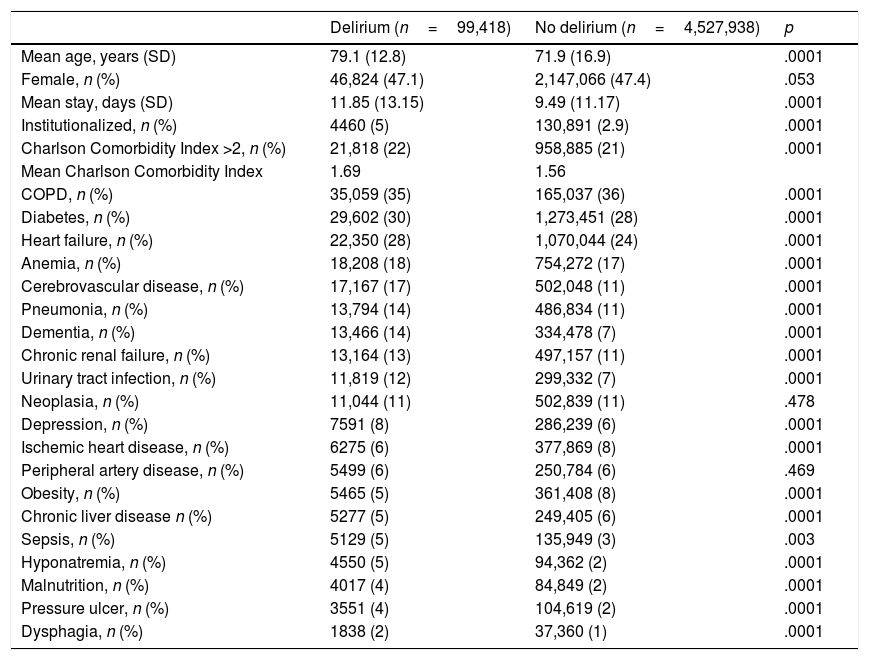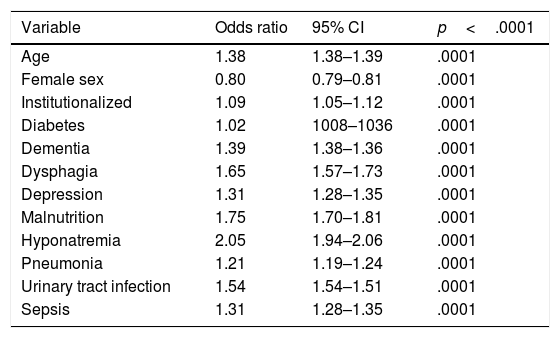To investigate the prevalence of reported delirium and its associated factors and costs.
DesignRetrospective and descriptive analysis of a national clinical-administrative database that includes all patients hospitalized in Spain in internal medicine departments from January 2007 to December 2014.
Material and methodThe study included the patients’ sociodemographic and clinical data (sex, age, diagnosis and procedures).
ResultsThe prevalence of reported delirium was 2.5% (114,343 of 4,628,397 discharge reports). Delirium was most common in the 81–90-year age group (48%) and in institutionalized patients (4.5% vs. 2.9%; p<.001). The diagnoses most associated with delirium were dementia (14% vs. 7% for patients without delirium), cerebrovascular disease (17% vs. 11%), malnutrition (4% vs. 2%), pressure ulcers (4% vs. 2%), dysphagia (2% vs. 0.2%) and hyponatraemia (5% vs. 2%) (p<.001 in all cases). Patients with delirium also had longer mean stays (11.85±13.15days vs. 9.49±11.17) and higher hospital mortality (OR: 1.41; 95%CI: 1.39–1.43; p=.0001).
The costs attributable to delirium in 8 years exceeded €100 million (almost €1000 per hospitalization/patient). We developed a predictive model for the risk of developing delirium, which has insufficient sensitivity but is useful for identifying low-risk patients.
ConclusionsPatients who develop delirium during their hospitalization in internal medicine have a longer stay, greater mortality and an increased risk of being institutionalized at discharge. Delirium is probably poorly reported in the discharge reports prepared by internists.
Investigar la prevalencia del delirio reportado, los factores asociados y los costes.
DiseñoAnálisis retrospectivo y descriptivo de una base de datos clínico-administrativa nacional que incluye todos los pacientes ingresados en España en los servicios de medicina interna desde enero de 2007 a diciembre de 2014.
Material y métodoSe incluyen datos sociodemográficos y clínicos (sexo, edad, diagnóstico y procedimientos), entre otros.
ResultadosLa prevalencia del delirio reportado fue del 2,5% (114.343 de 4.628.397 informes de alta). El delirio fue más frecuente en el grupo de 81 a 90 años (48%) y en pacientes institucionalizados (4,5% vs 2,9%; p<0,001). Los diagnósticos más asociados al delirio fueron demencia (14% vs 7% en los sujetos sin delirio), enfermedad cerebrovascular (17% vs 11%), desnutrición (4% vs 2%), úlceras por presión (4% vs 2%), disfagia (2% vs 0,2%) e hiponatremia (5% vs 2%); p<0,001 en todos los casos. También tuvieron una estancia media más larga: 11,85 (DE: 13,15) días vs 9,49 (DE: 11,17) días, y mortalidad intrahospitalaria más elevada (OR: 1,41; IC95%: 1,39-1,43; p=0,0001).
El coste atribuible al delirio en 8años supera los 100 millones de euros (casi 1.000€ por ingreso/paciente). Elaboramos un modelo predictivo del riesgo de desarrollar delirio sin sensibilidad suficiente pero útil para identificar pacientes de bajo riesgo.
ConclusionesLos pacientes que desarrollan delirio durante su ingreso en medicina interna tienen una estancia más prolongada, mayor mortalidad y mayor riesgo de ser institucionalizados al alta. El delirio está probablemente poco reportado en los informes de alta que elaboran los internistas.
Article
Diríjase desde aquí a la web de la >>>FESEMI<<< e inicie sesión mediante el formulario que se encuentra en la barra superior, pulsando sobre el candado.

Una vez autentificado, en la misma web de FESEMI, en el menú superior, elija la opción deseada.

>>>FESEMI<<<














